前回の続きです。
春のパン祭り点数集計を進めていきます。
方針再検討
前回の結果を振り返りつつ、改めて方式を検討します。
前回の状況
- Hue画像での2値化から、シール領域の輪郭取得を実施した
- シールの重なりにより、輪郭どうしがつながってしまっていた
輪郭がつながってしまった件について、Watershedアルゴリズムも考えていましたが、参考サイトを見ると、まずシール領域の中心付近の領域を取得して、そこから領域を広げていきながら境界を見つける、という処理のよう。

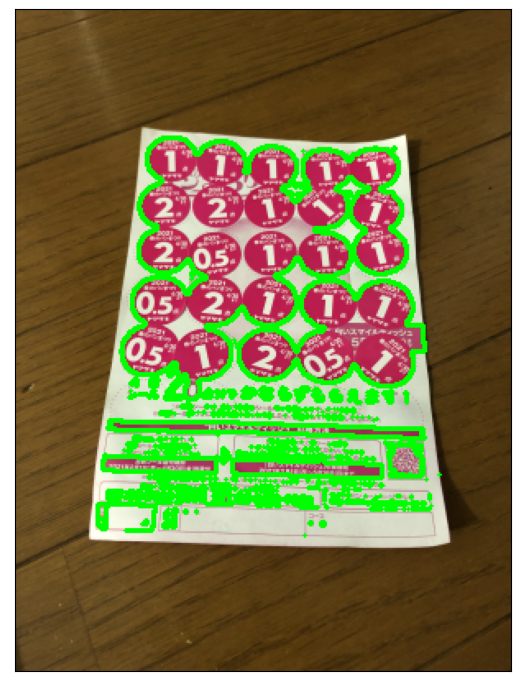
前回の画像を見ると、収縮処理や距離変換でシール領域の中心を見つけるのは難しそう。
ということでWatershedアルゴリズムもやってみたかったけど諦めます。
ただ、この2値化画像の最外周輪郭を見ると、全てのシールが内側に含まれていて、この内側の輪郭で点数文字が取得できそうに思えます。
点数文字を取得したら、そこからテンプレートマッチングで点数を識別します。
これを進めてみたいと思います。
台紙やシールの外形によるスケーリング、変形も考えていましたが、これは諦めで。
下準備
まずはいつもの下準備から。前回の5番目画像だけでやります。
※今回、cv2.resize()での縮小率を0.1から0.2に変更しています。
元の縮小率で進めていましたが、うまくいかなかったりしたので。
あまり大きくすると処理が重くなりそうですが、適度な解像度がありそうです。
import cv2
import numpy as np
%matplotlib inline
from matplotlib import pyplot as plt
img5 = cv2.imread('harupan_210402_1.jpg')
img5 = cv2.resize(img5, None, fx=0.2, fy=0.2, interpolation=cv2.INTER_AREA)
print(img5.shape)
(806, 605, 3)
plt.figure(figsize=(6.4,100), dpi=100)
plt.imshow(cv2.cvtColor(img5, cv2.COLOR_BGR2RGB)), plt.xticks([]), plt.yticks([])
plt.show()
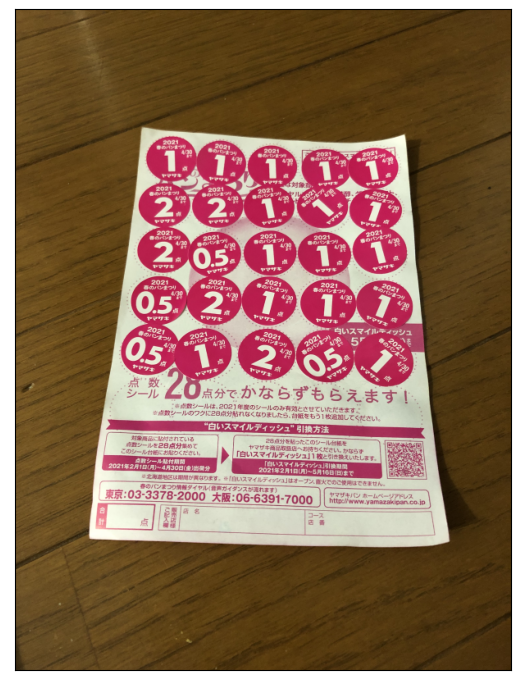
輪郭取得
輪郭を取得しますが、輪郭の階層を利用します。
cv2.findContour()関数では、輪郭取得のモード指定で、輪郭の階層構造も一緒に取得できます。
https://docs.opencv.org/4.5.2/d9/d8b/tutorial_py_contours_hierarchy.html
前回はcv2.RETR_EXTERNALを指定したので最外周輪郭のみ取得になりましたが、cv2.RETR_TREEであれば全輪郭と全階層構造を取得できます。
階層構造は、(1,輪郭の数,4)の形状のndarrayとして得られて、1輪郭あたりの情報としては[Next, Previous, First_Child, Parent]という形で輪郭のインデックスが入ってきます。該当する輪郭がなければ-1が入ります。
- Next: 同じ階層の次の輪郭
- Previous: 同じ階層の前の輪郭
- First_Child: 一つ下の階層の1番目の輪郭
- Parent: 1つ上の階層の輪郭
全輪郭の取得、表示
まず全輪郭を見てみて、点数文字の輪郭が取れていそうか確認します。
img5_hsv = cv2.cvtColor(img5, cv2.COLOR_BGR2HSV)
ret, img5_th_hue = cv2.threshold(img5_hsv[:,:,0], 135, 255, cv2.THRESH_BINARY)
img5_contours, img5_hierarchy = cv2.findContours(img5_th_hue, cv2.RETR_TREE, cv2.CHAIN_APPROX_SIMPLE)
img5_with_contours = cv2.drawContours(img5.copy(), img5_contours, -1, (0,255,0), 2)
plt.figure(figsize=(6.4,100), dpi=100)
plt.imshow(cv2.cvtColor(img5_with_contours, cv2.COLOR_BGR2RGB)), plt.xticks([]), plt.yticks([])
plt.show()
print('Shape: ', img5_hierarchy.shape, '\nContents: \n', img5_hierarchy[0,0:20,:], ' ...')
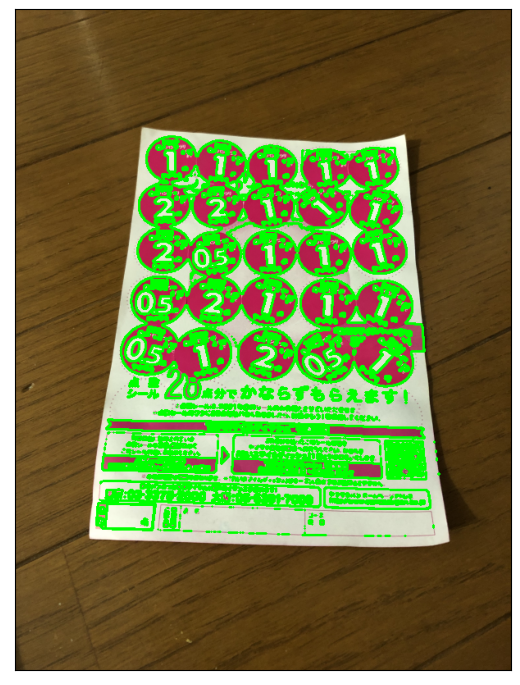
Shape: (1, 1618, 4)
Contents:
[[ 1 -1 -1 -1]
[ 2 0 -1 -1]
[ 3 1 -1 -1]
[ 4 2 -1 -1]
[ 5 3 -1 -1]
[ 6 4 -1 -1]
[ 7 5 -1 -1]
[ 8 6 -1 -1]
[ 9 7 -1 -1]
[10 8 -1 -1]
[11 9 -1 -1]
[12 10 -1 -1]
[13 11 -1 -1]
[14 12 -1 -1]
[15 13 -1 -1]
[16 14 -1 -1]
[17 15 -1 -1]
[18 16 -1 -1]
[19 17 -1 -1]
[20 18 -1 -1]] ...
大丈夫そうです。
輪郭を階層ごとに分ける
最外周輪郭は、Parentが-1になっている輪郭、ということで探せます。そしてもう1つ下の階層の輪郭は、最外周輪郭をParentとする輪郭、ということで探せます。
img5_indices_level0 = [i for i,hier in enumerate(img5_hierarchy[0,:,:]) if hier[3] == -1]
img5_contours_level0 = [img5_contours[i] for i in img5_indices_level0]
img5_hierarchy_level0 = [img5_hierarchy[0,i,:] for i in img5_indices_level0]
print('Contours Level0')
print(' Number of contours: ', len(img5_hierarchy_level0))
print(' Indices: ', img5_indices_level0[0:min(100,len(img5_indices_level0))], ' ...')
print(' Contents:')
[print(img5_hierarchy_level0[i]) for i in range(20)];
print('...')
Contours Level0
Number of contours: 499
Indices: [0, 1, 2, 3, 4, 5, 6, 7, 8, 9, 10, 11, 12, 13, 14, 15, 16, 17, 18, 19, 20, 21, 22, 23, 24, 25, 26, 27, 28, 30, 31, 32, 33, 34, 35, 36, 37, 38, 39, 40, 41, 42, 43, 44, 45, 46, 47, 48, 49, 50, 51, 52, 53, 54, 55, 56, 64, 66, 68, 70, 72, 73, 74, 75, 76, 79, 80, 81, 82, 83, 84, 85, 87, 90, 91, 92, 93, 94, 95, 96, 97, 98, 99, 100, 103, 104, 105, 106, 107, 108, 109, 110, 111, 112, 113, 118, 119, 120, 123, 124] ...
Contents:
[ 1 -1 -1 -1]
[ 2 0 -1 -1]
[ 3 1 -1 -1]
[ 4 2 -1 -1]
[ 5 3 -1 -1]
[ 6 4 -1 -1]
[ 7 5 -1 -1]
[ 8 6 -1 -1]
[ 9 7 -1 -1]
[10 8 -1 -1]
[11 9 -1 -1]
[12 10 -1 -1]
[13 11 -1 -1]
[14 12 -1 -1]
[15 13 -1 -1]
[16 14 -1 -1]
[17 15 -1 -1]
[18 16 -1 -1]
[19 17 -1 -1]
[20 18 -1 -1]
...
img5_indices_level1 = [i for i,hier in enumerate(img5_hierarchy[0,:,:]) if hier[3] in img5_indices_level0]
img5_contours_level1 = [img5_contours[i] for i in img5_indices_level1]
img5_hierarchy_level1 = [img5_hierarchy[0,i,:] for i in img5_indices_level1]
print('Contours Level1')
print(' Number of contours: ', len(img5_hierarchy_level1))
print(' Indices: ', img5_indices_level1[0:min(100,len(img5_indices_level1))], ' ...')
print(' Contents:')
[print(img5_hierarchy_level1[i]) for i in range(20)];
print('...')
Contours Level1
Number of contours: 1094
Indices: [29, 57, 58, 60, 65, 67, 69, 71, 77, 78, 86, 88, 89, 101, 102, 114, 115, 116, 117, 121, 122, 125, 128, 129, 135, 137, 138, 147, 169, 170, 183, 184, 226, 227, 228, 253, 268, 269, 270, 271, 272, 273, 274, 275, 276, 277, 278, 279, 280, 281, 282, 283, 284, 285, 286, 287, 288, 289, 292, 293, 294, 295, 296, 297, 298, 299, 300, 301, 302, 303, 304, 305, 306, 307, 308, 309, 310, 311, 312, 321, 322, 339, 354, 358, 364, 381, 382, 384, 388, 389, 390, 391, 392, 393, 394, 395, 396, 397, 398, 399] ...
Contents:
[-1 -1 -1 28]
[58 -1 -1 56]
[60 57 59 56]
[-1 58 61 56]
[-1 -1 -1 64]
[-1 -1 -1 66]
[-1 -1 -1 68]
[-1 -1 -1 70]
[78 -1 -1 76]
[-1 77 -1 76]
[-1 -1 -1 85]
[89 -1 -1 87]
[-1 88 -1 87]
[102 -1 -1 100]
[ -1 101 -1 100]
[115 -1 -1 113]
[116 114 -1 113]
[117 115 -1 113]
[ -1 116 -1 113]
[122 -1 -1 120]
...
img5_with_contours0 = cv2.drawContours(img5.copy(), img5_contours_level0, -1, (0,255,0), 2)
img5_with_contours1 = cv2.drawContours(img5.copy(), img5_contours_level1, -1, (0,255,0), 2)
plt.figure(figsize=(6.4,100), dpi=100)
plt.subplot(121), plt.imshow(cv2.cvtColor(img5_with_contours0, cv2.COLOR_BGR2RGB)), plt.title('Level0'), plt.xticks([]), plt.yticks([])
plt.subplot(122), plt.imshow(cv2.cvtColor(img5_with_contours1, cv2.COLOR_BGR2RGB)), plt.title('Level1'), plt.xticks([]), plt.yticks([])
plt.show()
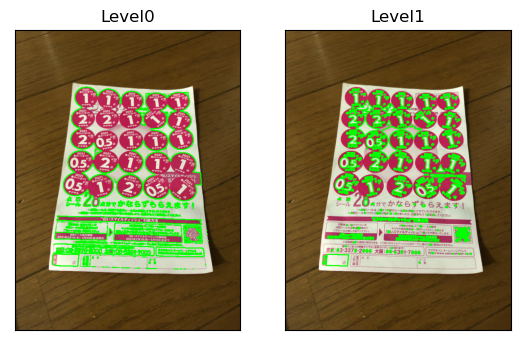
それらしい感じになりました。
モルフォロジー変換での2値化画像の調整
Level1の輪郭を見ると、細かい文字の部分の輪郭も取ってしまっているように見えます。
2値化の後にモルフォロジー変換のClosing処理(収縮→膨張)をやってから輪郭検出してみます。
kernel = np.ones((3,3),np.uint8)
img5_th_hue2 = cv2.morphologyEx(img5_th_hue, cv2.MORPH_CLOSE, kernel)
img5_contours, img5_hierarchy = cv2.findContours(img5_th_hue2, cv2.RETR_TREE, cv2.CHAIN_APPROX_SIMPLE)
img5_indices_level0 = [i for i,hier in enumerate(img5_hierarchy[0,:,:]) if hier[3] == -1]
img5_contours_level0 = [img5_contours[i] for i in img5_indices_level0]
img5_hierarchy_level0 = [img5_hierarchy[0,i,:] for i in img5_indices_level0]
img5_indices_level1 = [i for i,hier in enumerate(img5_hierarchy[0,:,:]) if hier[3] in img5_indices_level0]
img5_contours_level1 = [img5_contours[i] for i in img5_indices_level1]
img5_hierarchy_level1 = [img5_hierarchy[0,i,:] for i in img5_indices_level1]
img5_with_contours0 = cv2.drawContours(img5.copy(), img5_contours_level0, -1, (0,255,0), 2)
img5_with_contours1 = cv2.drawContours(img5.copy(), img5_contours_level1, -1, (0,255,0), 2)
plt.figure(figsize=(6.4,100), dpi=100)
plt.imshow(cv2.cvtColor(img5_with_contours1, cv2.COLOR_BGR2RGB)), plt.xticks([]), plt.yticks([])
plt.show()
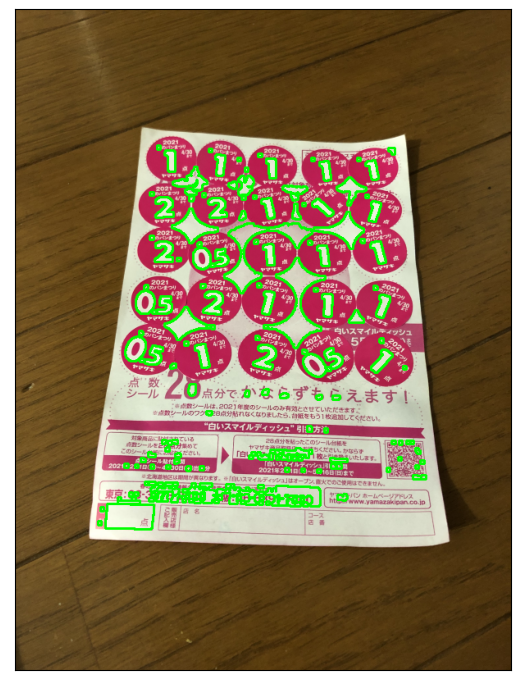
いい感じになってきました。
輪郭面積によるフィルタリング
ついでに、極端に小さい面積の輪郭は除去したほうがいいのかなと。
面積のヒストグラムを見てみます。
img5_areas_level1 = [cv2.contourArea(ctr) for ctr in img5_contours_level1]
plt.hist(img5_areas_level1, 100)
plt.show()
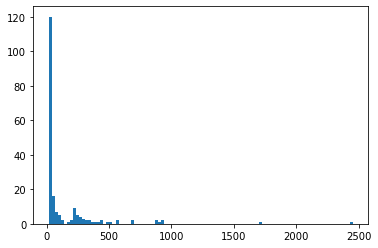
小さい面積の部分を拡大してみると、
plt.hist(img5_areas_level1, 100, [0,500])
plt.show()
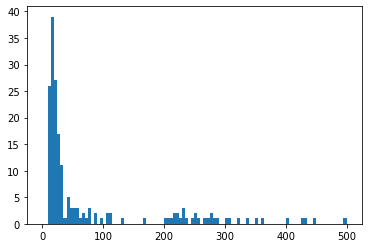
面積100pixel分を閾値としてやってみます。
100pixelというと、10x10pixelぐらいの領域ですが、今回の画像は800x600ピクセルぐらいだったので、画像全体に対して縦1/80、横1/60ぐらい→画像全体の面積の1/4800のサイズになります。
それに対して、点数文字の大きさをかなりおおざっぱに
- シール台紙が画像全体の縦横半分程度は写っているとする (写るようにする)
- シールが縦横に5個ずつ並んでいる
- 点数文字はシールのおよそ縦横半分程度の大きさはある
と考えると、画像全体に対してだいたい縦横1/20ぐらい→画像全体の面積の1/400程度のサイズとなります。
今回の画像でいうと、1000pixelぐらいになる?
ヒストグラムを見ると、200~500pixelあたりの面積の輪郭が点数文字に当たるかと。誤差は大きいですが、およそスケール感としてはそんなところかと。
画像全体の1/4000ぐらいを閾値とするのでいいかと思います。
img5_contours_level1_2 = [ctr for ctr in img5_contours_level1 if cv2.contourArea(ctr) > 100]
img5_with_contours1 = cv2.drawContours(img5.copy(), img5_contours_level1_2, -1, (0,255,0), 2)
plt.figure(figsize=(6.4,100), dpi=100)
plt.imshow(cv2.cvtColor(img5_with_contours1, cv2.COLOR_BGR2RGB)), plt.title('Level1'), plt.xticks([]), plt.yticks([])
plt.show()
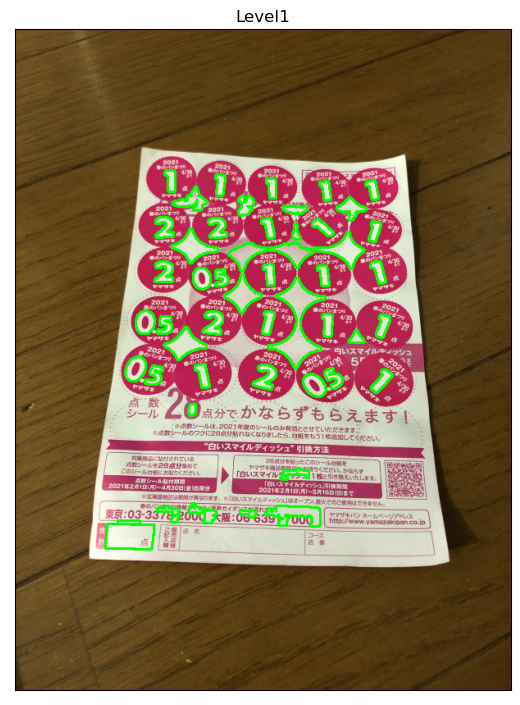
よりいい感じになってきました。
今回はここまで
少し違うものも混ざってしまっていますが、およそいい感じに点数文字の輪郭が取れました。
次回はここから点数文字のテンプレートマッチングをやっていきたいと思います。
ついでに
一応元の縮小率(0.1)での結果を出しておきます。
輪郭面積でのフィルタリングのとき、面積の閾値は、縮小率が2倍になっていることを考慮して、上での閾値の1/4 -> 25とします。
img5_01 = cv2.imread('harupan_210402_1.jpg')
img5_01 = cv2.resize(img5_01, None, fx=0.1, fy=0.1, interpolation=cv2.INTER_AREA)
img5_01_hsv = cv2.cvtColor(img5_01, cv2.COLOR_BGR2HSV)
ret, img5_01_th_hue = cv2.threshold(img5_01_hsv[:,:,0], 135, 255, cv2.THRESH_BINARY)
img5_01_th_hue = cv2.morphologyEx(img5_01_th_hue, cv2.MORPH_CLOSE, kernel)
img5_01_contours, img5_01_hierarchy = cv2.findContours(img5_01_th_hue, cv2.RETR_TREE, cv2.CHAIN_APPROX_SIMPLE)
img5_01_indices_level0 = [i for i,hier in enumerate(img5_01_hierarchy[0,:,:]) if hier[3] == -1]
img5_01_contours_level0 = [img5_01_contours[i] for i in img5_01_indices_level0]
img5_01_indices_level1 = [i for i,hier in enumerate(img5_01_hierarchy[0,:,:]) if hier[3] in img5_01_indices_level0]
img5_01_contours_level1 = [img5_01_contours[i] for i in img5_01_indices_level1]
img5_01_contours_level1_2 = [ctr for ctr in img5_01_contours_level1 if cv2.contourArea(ctr) > 25]
img5_01_with_contours1_2 = cv2.drawContours(img5_01.copy(), img5_01_contours_level1_2, -1, (0,255,0), 2)
img5_01_with_contours0 = cv2.drawContours(img5_01.copy(), img5_01_contours_level0, -1, (0,255,0), 1)
img5_01_with_contours1 = cv2.drawContours(img5_01.copy(), img5_01_contours_level1, -1, (0,255,0), 1)
img5_01_with_contours1_2 = cv2.drawContours(img5_01.copy(), img5_01_contours_level1_2, -1, (0,255,0), 1)
plt.figure(figsize=(100,100), dpi=100)
plt.subplot(131), plt.imshow(cv2.cvtColor(img5_01_with_contours0, cv2.COLOR_BGR2RGB)), plt.title('Level0'), plt.xticks([]), plt.yticks([])
plt.subplot(132), plt.imshow(cv2.cvtColor(img5_01_with_contours1, cv2.COLOR_BGR2RGB)), plt.title('Level1'), plt.xticks([]), plt.yticks([])
plt.subplot(133), plt.imshow(cv2.cvtColor(img5_01_with_contours1_2, cv2.COLOR_BGR2RGB)), plt.title('Level1_2'), plt.xticks([]), plt.yticks([])
plt.show()
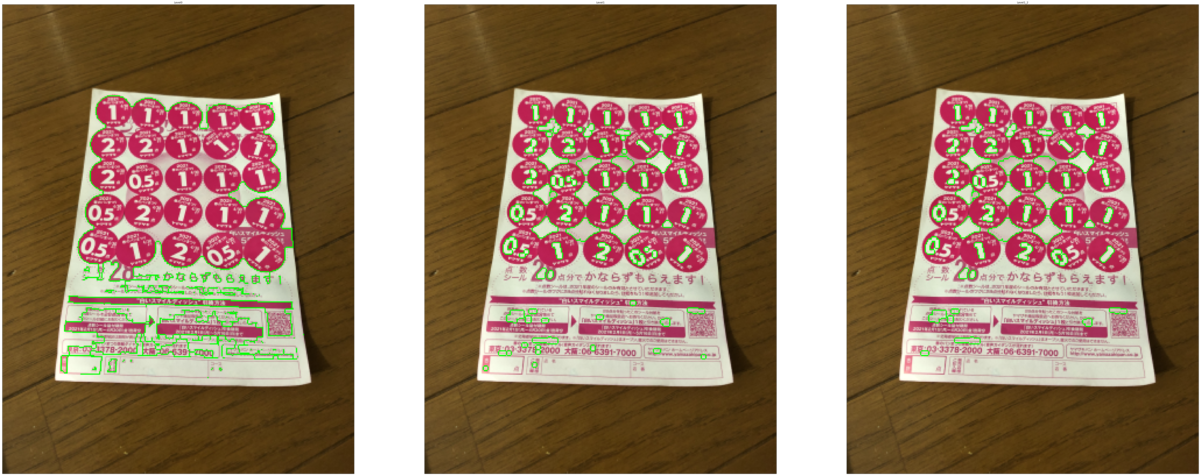
こちらでは、2や5の文字輪郭がうまく取得できませんでした。
ただ、この後試しにモルフォロジー変換なしでやってみると、
ret, img5_01_th_hue = cv2.threshold(img5_01_hsv[:,:,0], 135, 255, cv2.THRESH_BINARY)
img5_01_contours, img5_01_hierarchy = cv2.findContours(img5_01_th_hue, cv2.RETR_TREE, cv2.CHAIN_APPROX_SIMPLE)
img5_01_indices_level0 = [i for i,hier in enumerate(img5_01_hierarchy[0,:,:]) if hier[3] == -1]
img5_01_contours_level0 = [img5_01_contours[i] for i in img5_01_indices_level0]
img5_01_indices_level1 = [i for i,hier in enumerate(img5_01_hierarchy[0,:,:]) if hier[3] in img5_01_indices_level0]
img5_01_contours_level1 = [img5_01_contours[i] for i in img5_01_indices_level1]
img5_01_contours_level1_2 = [ctr for ctr in img5_01_contours_level1 if cv2.contourArea(ctr) > 25]
img5_01_with_contours1_2 = cv2.drawContours(img5_01.copy(), img5_01_contours_level1_2, -1, (0,255,0), 2)
img5_01_with_contours0 = cv2.drawContours(img5_01.copy(), img5_01_contours_level0, -1, (0,255,0), 1)
img5_01_with_contours1 = cv2.drawContours(img5_01.copy(), img5_01_contours_level1, -1, (0,255,0), 1)
img5_01_with_contours1_2 = cv2.drawContours(img5_01.copy(), img5_01_contours_level1_2, -1, (0,255,0), 1)
plt.figure(figsize=(100,100), dpi=100)
plt.subplot(131), plt.imshow(cv2.cvtColor(img5_01_with_contours0, cv2.COLOR_BGR2RGB)), plt.title('Level0'), plt.xticks([]), plt.yticks([])
plt.subplot(132), plt.imshow(cv2.cvtColor(img5_01_with_contours1, cv2.COLOR_BGR2RGB)), plt.title('Level1'), plt.xticks([]), plt.yticks([])
plt.subplot(133), plt.imshow(cv2.cvtColor(img5_01_with_contours1_2, cv2.COLOR_BGR2RGB)), plt.title('Level1_2'), plt.xticks([]), plt.yticks([])
plt.show()
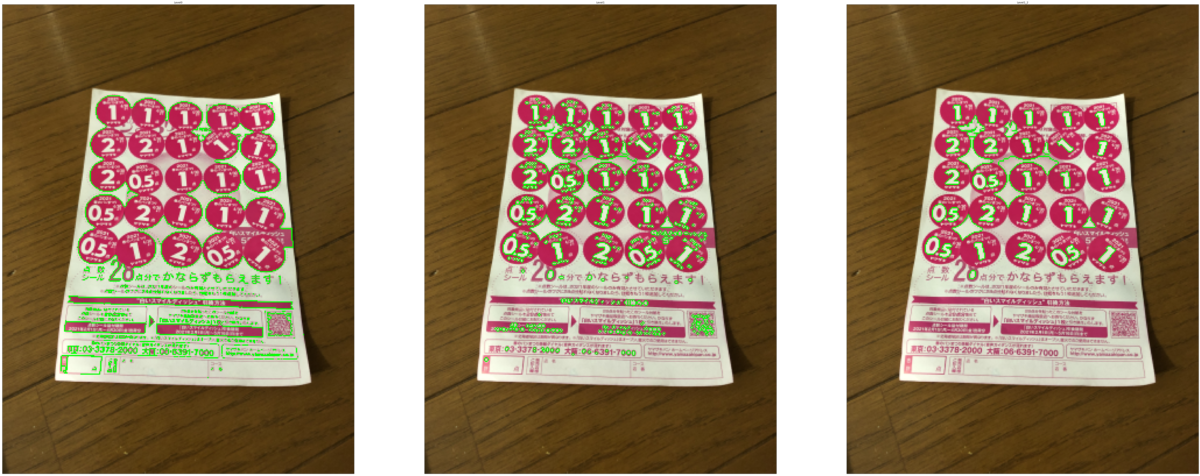
という感じで、縮小率を変える前と同様の輪郭が取れました。
- 縮小率の高い画像にとっては3x3のカーネルが大き過ぎた
- 輪郭面積でのフィルタリングでも、結果的にモルフォロジー変換を適用したのと同じ結果が得られる
ということかと思います。
ただ、縮小率0.2での輪郭に比べると、解像度不足からぎざぎざしてしまっている感じがするので、やっぱり縮小率0.2で進めていきたいと思います。
検出対象の画像データ中の大きさを意識しておく必要がる、ということかと思います。
は置いておいて、
行列
のほうを考えます。
の要素に特に制約はありません(2次元座標変換には他にユークリッド変換、相似変換がありますが、変換行列に制約がある)が、この要素の意味合いを少し考えてみました。

軸と
軸、垂直に
軸を定義しています。
軸、これに垂直な被写体平面内の軸を
軸と定義します。
軸に垂直な視点から見た図です。

軸と
軸を使って被写体の座標を表すことを考えます。
軸は
軸に対して
の角度(角度をどう取るかはもう少し考えたほうがよさそう…)となっているので、
での座標から
での座標への変換は、
軸を含む面で見てみます。

軸座標と撮像面上の座標tex:uはシンプルな関係にはなりませんが、カメラの光学中心と被写体平面間の距離がカメラの奥行方向に大きく変動しなければ、図の緑の面(撮像面に平行)に射影した点で近似することができ、そうすると2つの座標間の関係は
軸を含む面で見ると、こちらは
軸とカメラ軸が直交するのでシンプルになります。

座標と撮像面上の座標
の関係は
軸、
軸上にない点についても同様で、まとめると、
とすると、回転後の
軸、
軸座標について、

と撮像面上の点
の間に以下の関係が成り立ちます。
は2x2行列で、4つの任意なパラメータを持ちますが、
これがアフィン変換の行列
に当たるということになります。
の要素と4つのパラメータ(
)の関係が出て、かつこれらのパラメータにより行列
の要素を任意に設定できることが示せるかと思います。



































































